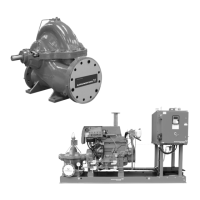English (GB)
22
13. Fault finding
13.1 Pump set with diesel engine
Warning
Before starting service work, make sure that the
pump set cannot accidentally start.
Fault Cause Remedy
1. Pump delivers no or
too little water.
a) Air in suction pipe. Fill priming tank with water and vent pump. Make sure that
the suction pipe has been installed according to section
6.5 Pipe connection.
b) Pump draws in air due to defective seals. Check pipe and pump housing gaskets, and replace if
necessary.
c) Counter-pressure is too high. Check the sprinkler system for impurities and blockages.
d) Inlet pressure is too low. Make sure that the storage tank is filled with water and that
the conditions in section 15.6 Minimum inlet pressure are
complied with.
e) Suction pipe or impeller is blocked. Clean the suction pipe and pump.
2. Pump makes too
much noise. Pump
runs unevenly and
vibrates.
a) Inlet pressure is too low (cavitation). Make sure that the storage tank is filled with water and that
the conditions in section 15.6 Minimum inlet pressure are
complied with.
b) Air in suction pipe. Fill priming tank with water. Vent pump. Make sure that the
suction pipe has been installed according to section 6.5 Pipe
connection.
c) Impeller out of balance. Clean the impeller and remove foreign particles.
d) Inner parts worn. Replace defective parts. See service instructions for the
pump.
e) Pump stressed by the pipework. Mount the pump so that it is not stressed. Support the pipes.
See section 6.5 Pipe connection.
f) Defective bearings. Replace bearings.
g) Defective coupling. Replace the coupling.
h) Foreign bodies in the pump. Clean the pump and remove foreign bodies.
3. Leaking pump
housing.
a) Pump stressed by the pipework. Mount the pump so that it is not stressed. Support the pipes.
See section 6.5 Pipe connection.
b) Pump housing gaskets or flange gaskets
defective.
Replace defective gaskets.
4. Leaking shaft seal. a) Shaft seal dirty or seized up. Check and clean the shaft seal.
b) Shaft seal defective. Replace the shaft seal. See service instructions for the pump.
c) Shaft surface or shaft sleeve defective. Replace the shaft or the shaft sleeve. See service instructions
for the pump.
5. Too high pump
temperature.
a) Air in pump. Fill the priming tank with water and vent the pump.
b) Inlet pressure is too low. Make sure that the storage tank is filled with enough water
and that the conditions in section 15.6 Minimum inlet
pressure are complied with.
c) Bearings lubricated with too little, too
much or unsuitable lubricant.
Replenish, reduce or replace the lubricant.
d) Pump bearing seat stressed by pipework. Mount the pump so that it is not stressed. Support the pipes.
Check the alignment of the pump, and correct, if necessary.
See section 6.5 Pipe connection and 6.4 Alignment.
e) Axial pressure too high. Check the relief holes of the impeller and the lock rings on the
suction side.

